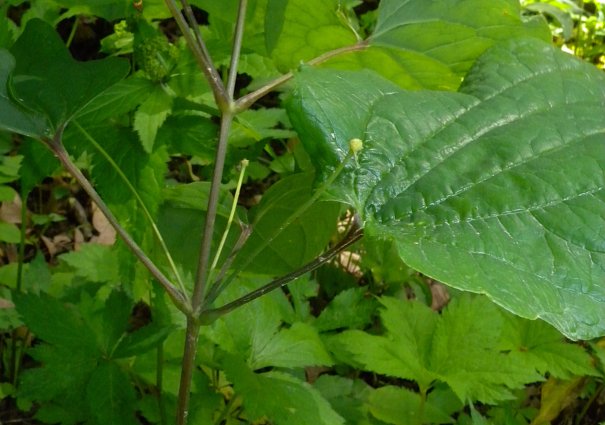
The blooming period occurs from late spring to early summer, lasting about 2 weeks. The flowers have an unpleasant odor that resembles decaying carrion. Afterwards, fertile female flowers are replaced by berries that become mature during late summer or autumn. Mature berries are about 8 mm. (1/3") across, dark blue-violet to black, and globoid in shape; the fleshy interiors of these berries contain 1-6 seeds. This plant reproduces by reseeding itself.
Cultivation: The preference is partial sun to light shade, moist to mesic conditions, and a relatively loose soil containing loam and decaying organic matter. Plants that are grown in moderate to dense shade often fail to produce flowers and berries. Most growth and development occur during the spring and early summer.
Range & Habitat: The native Upright Carrion Flower is occasional in the northern half of Illinois, while in the southern half of the state it is rare or absent (see Distribution Map). Habitats include moist to mesic deciduous woodlands, bottoms of wooded bluffs, shady ravines, banks of woodland streams, open woodlands, and thickets. Populations of this plant are threatened by the overpopulation of White-tailed Deer, invasion of non-native shrubs and Garlic Mustard (Alliaria petiolata), and habitat destruction from development. It is a fairly conservative species that is found in high quality natural areas.

Faunal Associations: The stinky flowers of Upright Carrion Flower are cross-pollinated by various kinds of flies, including Anthomyiid flies, Calliphorid flies, Muscid flies, and flesh flies (Sarcophagidae). They are also visited by Halictid bees (including green metallic bees) and miscellaneous beetles. Both nectar and pollen are available as floral rewards (the latter is found only on plants with male flowers); see Graenicher (1902) for more information. Various insects are known to feed destructively on the foliage and other parts of Smilax spp. (Greenbrier, Carrion Flower). Examples include the leaf beetle Pachyonychus paradoxus, larvae of Dasineura smilacifolia (Smilax Leaf Midge) and Camptoneuromyia rubifolia (Smilax Blister Midge), and larvae of such moths as Proleucoptera smilaciella, Phosphila miselioides (Spotted Phosphila), Phosphila turbulenta (Turbulent Phosphila), Phyprosopus callitrichoides (Curve-lined Owlet), Pseudogalleria inimicella (Inimical Borer Moth), and Papaipema unimoda (Meadow Rue Borer Moth); see Clark et al. (2004), Felt (1917), Needham et al. (1928), Wagner (2005), and Miller (1987). Another insect feeder, Neoprociphilus aceris (Woolly Maple Aphid), uses Smilax spp. as summer hosts, sucking juices from their stems and leaves (Blackman & Eastop, 2013). Upland gamebirds, songbirds, and other birds feed on the berries, spreading their seeds to new locations. These species include the Wood Duck, Ruffed Grouse, Wild Turkey, Cardinal, American Crow, Catbird, Brown Thrasher, American Robin, Fox Sparrow, and several thrushes (see the Bird Table for a more complete list of these species). The Black Bear, Opossum, Raccoon, Fox Squirrel, and Gray Squirrel also feed on the fruit, while White-tailed Deer browse on the leaves and stems (Martin et al., 1951/1961; Augustine, 1997).

Photographic Location: The Spitler Woods State Natural Area near Decatur, Illinois.
Comments: Among the various Smilax spp. that occur in Illinois, Upright Carrion Flower (Smilax ecirrhata) is one of the shortest and most erect. The only other species with this characteristic within the state, Illinois Carrion Flower (Smilax illinoensis), differs by having leaves that become smaller as they ascend upward, leaves that are more narrowly shaped and more rounded at their bases (rather than cordate), petioles that are as long or longer than the corresponding leaves to which they are attached, and umbels with more flowers. This latter species is less common than Upright Carrion Flower. Two other species, Common Carrion Flower (Smilax lasioneuron) and Smooth Carrion Flower (Smilax herbacea) are climbing vines up to 6-8' long that have abundant tendrils. Other Smilax spp. in Illinois are woody vines that are even longer; they are commonly referred to as Catbriers or Greenbriers. Another spelling of the scientific name for Upright Carrion Flower is Smilax ecirrata.